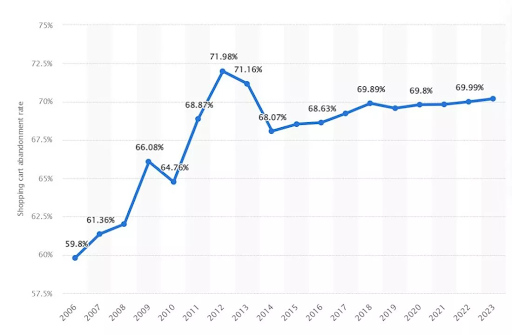People’s buying habits have drastically changed over the past few years due to technological advancements in the retail industry. Yet, many retailers struggle with outdated apps that fail to meet modern standards. This has prompted businesses to upgrade their tech ecosystems to fulfill customer demands.
Legacy app modernization in retail has become crucial to surviving the changing market dynamics. By modernizing their applications, businesses may update their software portfolio to benefit from modern tools, languages, infrastructure, and other aspects.
Ideal retail app optimization strategies may increase reliability, reduce costs, and attract new customers. It also explains why several retail businesses use retail application modernization services.
In this blog, we will discuss the challenges related to outdated retail apps, the crucial advantages of retail software modernization, the process for legacy app transformation, costs, and more.
Challenges Faced by Outdated Retail Apps
Discover how outdated retail apps hinder progress, customer experience, productivity, and scalability in this modern, fast-paced digital world.
-
Poor User Experience
An outdated look, cluttered layout, and slow performance confuse and frustrate users, leading to cart abandonment and less engagement. According to Statista, the global online shopping cart abandonment rate touched 70.19% in 2023 due to a poor experience.

-
Scalability Limitations
Legacy retail systems are not flexible enough to handle massive user traffic and inventory demands during peak hours. Moreover, other factors also limit the ability to expand and hinder growth, including:
- Outdated infrastructure
- Inadequate codebase
- Monolithic designs
- High maintenance costs
All the above pointers lead to performance bottlenecks and limited scalability.
-
Data Security Vulnerabilities
Obsolete retail apps fail to meet modern security standards such as firewalls, encryption protocols, and multifactor authentication. Additionally, they stop getting security updates from the original developers and vendors, which increases technical debt and exposes sensitive customer and business data to breaches and Cyberattacks, impacting trust and compliance.
-
Not Compatible with Modern Technology
Outdated retail apps generally lack compatibility with advanced APIs, which hinders integration. Furthermore, on-premise setups make them unsuitable for cloud application development. Apart from that, one of the biggest challenges of legacy retail apps is that they cannot utilize AI and ML, limiting innovation.
- Do not support modern API
- Absence of Cloud Compatibility
- Unable to use AI and ML
- No IoT Integration
- Rigid Architecture
-
High Maintenance Costs
Maintaining aging retail systems is resource-intensive and costly. They need constant patching to resolve issues. Older legacy retail apps use extensive resources, incurring higher operating costs. Additionally, frequent maintenance causes app downtimes that lead to poor returns on investment over time.
- Frequent bug fixes
- High resource consumption
- Increased downtime costs
- Limited vendor support
-
Inconsistent Omnichannel Experience
Legacy retail apps must synchronize data across channels, leading to consistent customer experiences between online and offline interactions. Moreover, they can not provide order updates and inventory details in real-time, increasing customer frustration and even causing sales opportunities to be lost.
- Disconnected Platforms
- Limited personalization
- Fragmented user experience
- Delayed transactions
Key Benefits of Retail Application Modernization
Let’s now examine the intriguing retail app modernization benefits in detail. Modernizing current retail applications is essential for several reasons, including:
-
Improved Decision-making Capabilities
Retail app modernization for enterprises helps improve employment decisions by offering real-time data and insights. With updated software, retailers monitor and evaluate variables, including consumer traffic, sales patterns, and inventory levels.
This data assists merchants in making well-informed staffing decisions by identifying peak hours and trending products. Retailers who thoroughly grasp customer demand may improve service and staffing schedules.
-
Enhanced User Experience
With state-of-the-art features and technologies, legacy retail app transformation offers simple checkout processes, smooth navigation, and tailored suggestions. These improvements make it easier for customers to find what they’re searching for, make purchases, and have a smooth shopping experience.
Additionally, mobile app development for the retail industry allows real-time inventory changes, ensuring customers receive accurate product availability information. It lessens the likelihood of disappointment when items go out of stock.
-
Increased Operational Productivity
Update outdated retail apps to achieve operational efficiency, including simplified procedures, real-time data, better collaboration, improved inventory management, and data analytics.
Optimized retail app solutions offer cutting-edge features and technology. Task automation is one significant advantage during the process. Modern retail app development also automates order processing and customer service processes.
Digital transformation in retail apps eliminates the need for manual intervention, reduces mistakes, and saves time.
-
Provide Omnichannel Experience
Strong omnichannel capabilities with modern retail app solutions transform how merchants interact with consumers across various channels. Businesses can provide a consistent and vital user experience by employing modernized retail software.
Customers may purchase and access services through various touchpoints, including websites, mobile applications, social media, and physical shops. Thanks to omnichannel features, businesses may provide click-and-collect services, which let customers place online orders and pick them up in-store.
Another essential component of retail & E-commerce solutions is the cross-channel integration of loyalty programs. Customers may earn and redeem rewards in person or online, which helps build customer loyalty.
-
Allow Retailers to Use Advanced Technologies
Mobile retail app modernization is essential when incorporating cutting-edge technologies like artificial intelligence, virtual reality, augmented reality, machine learning, and the Internet of Things in retail.
By updating their applications, retailers may take advantage of each technology’s capabilities and maintain their competitive edge in the retail market.
-
Improved Data Security and Compliance
Legacy retail app optimization implements robust security mechanisms to secure critical user data and information. Secure authentication solutions, including biometric authentication, two-factor authentication, and encryption, are included in the retail industry’s digital transformation.
An upgraded retail app can also include fraud detection and prevention technology to identify and reduce potential security threats. These systems can examine transaction history, client behavioral trends, and other data to find suspicious activity or fraudulent transactions.
Furthermore, frequent security audits and upgrades are necessary to protect E-commerce app development from new security flaws. This includes conducting penetration testing, maintaining the most recent security updates, and adhering to industry best practices to protect data from unauthorized access.
Crucial Steps For Legacy Retail App Transformation
Let’s see value-driven steps to modernize retail applications to improve performance and meet customer expectations.
-
Conduct a Detailed App Audit
This is the first step in transforming old retail apps. In this step, you must analyze app performance, gather user feedback, and check security vulnerabilities.
Your application modernization services provider identifies outdated features, bottlenecks, and gaps to create a roadmap for effective modernization.
-
Determine Modernization Goals
In this retail app transformation stage, you must define clear objectives, such as improving user experience, integrating AI, or reducing maintenance costs, to align the transformation with business growth and customer needs.
-
Redesign User Interface
A well-crafted and intuitive user experience is crucial in today’s cutthroat mobile application market.
Your UI/UX design services provider will revamp the user interface with interactive layouts, faster navigation, and visually appealing elements to enhance engagement and increase retention rates.
-
Integrate Advanced Technologies
If your old retail app does not use emerging technologies, you are lagging behind. Therefore, ask your retail app development services provider to incorporate AI, machine learning, AR in retail, or predictive analytics to drive personalized experiences and operational efficiency.
-
Upgrade Security Features
Security is paramount in legacy software modernization or any other app. Therefore, to safeguard customer and business data, you must adopt modern security protocols, such as end-to-end encryption, multi-factor authentication, and compliance with data regulations. This helps you avoid data breaches and hefty fines.
-
Ensure Seamless Migration
After upgrading the security features, you must migrate retail legacy applications to the new system using secure, efficient techniques to avoid downtime, data loss, or disruptions to operations.
-
Test Performance
AI for mobile app testing is critical before launching your app. It tells you if your app has any bugs or flaws. You must conduct a vulnerability assessment and penetration testing to test the retail app for speed, scalability, and functionality under various conditions. It ensures optimal performance even during high traffic.
-
Ongoing Maintenance
Regular updates and monitoring are essential to improving retail app functionality, ensuring compatibility with new technologies, and ensuring long-term relevance and reliability.
Technologies That Modernize Legacy Retail Software
You should leverage emerging technologies to enhance retail app performance for future-ready solutions.
-
AI and ML
Integrate artificial intelligence and machine learning to analyze vast datasets, offer personalized recommendations, and automate customer interactions, enhancing digital transformation for retail apps and operational efficiency.
-
Internet of Things (IoT)
IoT devices collect real-time data from physical assets, facilitating inventory management, supply chain optimization, and personalized in-store experiences, which improve retail app performance.
-
Blockchain
Blockchain technology ensures data integrity and enables secure, decentralized ecosystems, enhancing transparency and building customer trust in retail app transactions.
-
DevOps
DevOps practices streamline software product development and operations, promote continuous integration and delivery, accelerate software updates, and improve system reliability.
-
Chatbots and Virtual Assistants
AI chatbot development and virtual assistants provide instant customer support, handle inquiries, and assist in transactions, enhancing user experience and reducing operational costs.
-
Predictive Analytics
Predictive analytics leverage historical data to forecast trends, enabling retailers to optimize inventory, pricing strategies, and marketing campaigns, leading to increased profitability.
Success Stories of Digital Transformation in Retail Apps
Let us see the real-world retail app transformation that helped companies boost revenue, increase customer numbers, and build brand loyalty.
-
Sephora
Sephora integrated AR into its app, allowing users to try on makeup virtually. This feature increased user engagement and led to a 15% boost in online sales.
-
Nike
Nike included personalized fitness plans and objectives and AR shoe fittings. The update significantly improved customer retention rates and boosted app downloads by 45%.
-
Walmart
Walmart adopted AI-driven inventory management systems in its app, which reduced costs and enhanced operational efficiency.
The Cost of Optimized Retail App Solutions
The cost to optimize retail app solutions differs based on complexity, features, and technology. Generally, it ranges from $10,000 to $300,000. Key factors include development, platform choice, advanced technologies like AI or IoT, and ongoing maintenance costs. Investing in scalable and future-ready retail app modernization solutions enhances long-term business value and reduces inefficiencies.
Final Wordings
Outdated retail softwares or systems can pose a massive threat to the security, success, and growth of your business. A well-crafted legacy system modernization strategy can help increase the app’s reliability and scalability. By incorporating innovation-intensive and value-driven technologies such as AR/VR, AI/ML, IoT, and secure payment systems, retailers can now offer an engaging and personalized shopping experience.
From virtual try-ons to personalized suggestions, smooth transactions, and optimized operations, every retail app UI/UX modernization facet has been elevated to new heights. However, if you want to maximize the benefits of app modernization in the retail industry, consult with a legacy software modernization services provider for insights.
Frequently Asked Questions
Q: What steps are involved in the legacy retail app optimization process?
A: The retail app optimization strategies include various steps, such as conducting an app audit, setting modernization goals, redesigning the UI, integrating emerging tech, testing, and maintaining.
Q: How does retail app modernization enhance app performance and speed?
A: With retail software modernization, you can get scalable cloud infrastructure, well-crafted codes, and advanced tools that increase app reliability and speed.
Q: What are the key technologies for transforming retail apps?
A: AI, Blockchain, IoT, predictive analytics, chatbots, and DevOps are critical technologies for transforming retail applications. These technologies help in innovation, facilitate processes, and improve customer experiences.
Q: What are the most important performance upgrades for outdated retail apps?
A: To upgrade the performance of outdated retail apps, you can integrate real-time analytics, use cloud migration, improve security protocols, offer cross-platform compatibility, and implement various scalability features.





